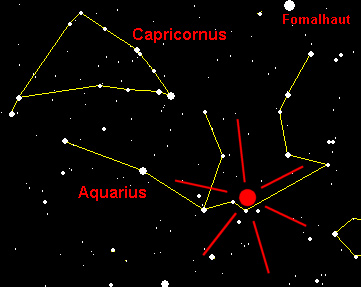
It's been 24 years sinceHalley's Comet last passed through the inner solar system, but remnants fromthe icy wanderer will light up the dawn sky this week in the Eta Aquarid meteorshower.
The meteorshower is predicted to peak early on Thursday morning, May 6. Underideal conditions (a dark, moonless sky) about 40 of these very swift meteorscan be seen per hour. The shower appears at about one-quarter peak strength forabout three or four days before and after May 6.
The famous Halley's Comettakes roughly 76 years to circle the sun and last passed through our cosmicneighborhood in 1986. Halley's orbit closely approaches the Earth's orbit intwo spots, offering two chances each year to see meteor showers left over fromthe comet's cosmic "litter."
One point is in the middle tolatter part of October, producing a meteor display known as theOrionids. The other point comes in the early part of May, producing theEta Aquarids.
When and Where to Watch
There are, however, two drawbacksif you plan to watch for the Eta Aquarids meteors this year. [Meteor shower map.]
First, there is the moon, whichwill be at Last Quarter on the peak morning and will likely "musclein" on the fainter meteor streaks by brightening the early morningsky with its bright light.
Breaking space news, the latest updates on rocket launches, skywatching events and more!
The other obstacle ? at least forthose watching from north of the equator ? is that the radiant (theemanation point of these meteors) is at the "Water Jar" of theconstellation Aquarius, which comes above the southeast horizon around 3 a.m.local daylight time, never gets very high as seen from north temperatelatitudes, so the actual observed rates are usually much lower thanthe oft-quoted 40 per hour.
In North America, typical ratesare 10 meteors per hour at 26-degrees north latitude, half this at 35-degreeslatitude and practically zero north of 40-degrees.
Conversely, those who live in theSouthern Hemisphere, where Aquarius rises much higher into the sky, considerthis to be one of the best meteor showers of the year.
Catch an Earthgrazer
For most, perhaps the besthope is catching a glimpseof a meteor emerging from the radiant that will skim the atmospherehorizontally ? much like a bug skimming the side window of an automobile.Meteor watchers call such shooting stars "Earthgrazers." They leavecolorful, long-lasting trails.
"These meteors are extremelylong," said Robert Lunsford, of the International Meteor Organization."They tend to hug the horizon rather than shooting overhead where mostcameras are aimed."
"Earthgrazers are rarelynumerous," cautions Bill Cooke, a member of the Space Environments team atthe Marshall Space Flight Center. "But even if you only see a few, you'relikely to remember them."
Comet Crumbs
If you do catch sight of one earlythese next few mornings, keep in mind that you'll likely be seeing theincandescent streak produced by material which originated from the nucleusof Halley's Comet.
When these tiny bits of thecomet collide with Earth, friction with our atmosphere raises them to whiteheat and produces the effect popularly referred to as "shootingstars."
So it is that the shooting starsthat we have come to call the Eta Aquarids are really an encounterwith the traces of a famous visitor from the depths of space and from the dawnof creation.
- Images - Stunning Meteor Showers, Part 2
- Fabulous Comet Photos
- Wisconsin Farmer Discovers Fragment of Exploded Meteor
Joe Rao serves as aninstructor and guest lecturer at New York's Hayden Planetarium. He writes aboutastronomy for The New York Times and other publications, and he is also anon-camera meteorologist for News 12 Westchester, New York.
Join our Space Forums to keep talking space on the latest missions, night sky and more! And if you have a news tip, correction or comment, let us know at: community@space.com.

Joe Rao is Space.com's skywatching columnist, as well as a veteran meteorologist and eclipse chaser who also serves as an instructor and guest lecturer at New York's Hayden Planetarium. He writes about astronomy for Natural History magazine, Sky & Telescope and other publications. Joe is an 8-time Emmy-nominated meteorologist who served the Putnam Valley region of New York for over 21 years. You can find him on Twitter and YouTube tracking lunar and solar eclipses, meteor showers and more. To find out Joe's latest project, visit him on Twitter.
